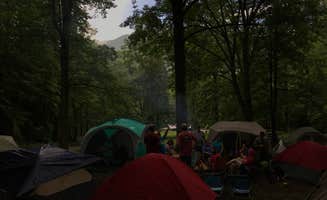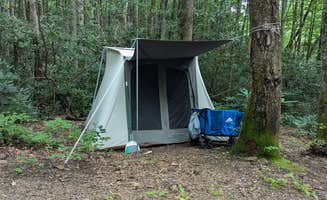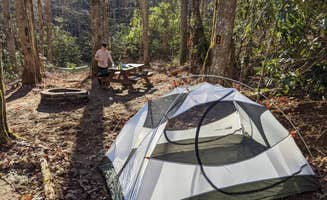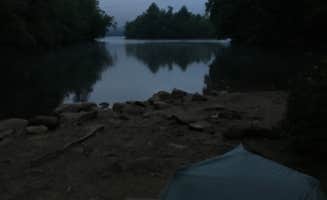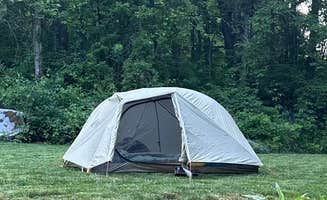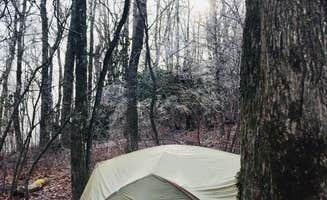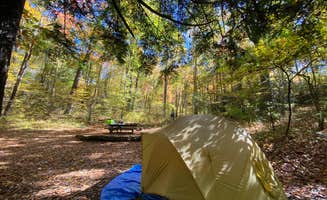Camping near Topton, North Carolina places visitors at elevations between 1,500-5,000 feet in the southwestern corner of the state, where the Nantahala National Forest meets the Great Smoky Mountains. Winter temperatures typically drop to the 20s-30s°F while summer days average 70-85°F with significantly cooler evenings at higher elevations. Dispersed campsites in this region often require high-clearance vehicles to access, particularly after periods of rain.
What to do
Mountain biking at Tsali trails: Located just 11 miles from Topton, the Tsali Campground offers direct access to over 40 miles of single-track mountain biking. "One of the best views of the lake and GSMNP that I know of," notes Mickey L. The trail system operates on an alternating schedule for bikes and horses, so check the posted signs before heading out.
Creek access for kids: Many campsites feature shallow creek access perfect for summer play. At Turkey Creek Campground in nearby Almond, "a small creek runs through the campground offering sweet sounds to fall asleep too," reports Jason L. Families particularly appreciate the natural water features during hot summer months.
Fishing at Lake Santeelah: Just 15 miles west of Topton, the Lake Santeelah Dispersed sites provide excellent bank fishing opportunities. "Not very far to walk to reach the lake and the fishing wasn't bad at all. Bass and Bluegills," reports WDRoberson. Most sites include direct lake access with flat tent pads and fire rings.
What campers like
Clean facilities: Campers consistently praise the well-maintained bathhouses in the region. "Cleanest bathrooms I have ever seen at a campground," writes Jason L. about Turkey Creek Campground. Even during peak season, many campgrounds maintain their facilities to high standards.
Proximity to Appalachian Trail: For serious hikers, Standing Indian Campground near Franklin provides excellent access to famous hiking routes. "A hikers dream with the Appalachian Trail skirting the campground and several other trails crossing through the campground," notes Phil L. The campground sits at over 4,000 feet elevation, offering significantly cooler temperatures during summer.
Firefly viewing: During late May and early June, Elkmont Campground in the nearby Great Smoky Mountains National Park becomes a destination for synchronous firefly viewing. "Is usually very crowed year round (especially during firefly season), but there is plenty of space between the campsites," reports Tyler M. Parking passes for the event are distributed by lottery in April.
What you should know
Cell service limitations: Expect minimal or no cell reception at most campgrounds. "There is absolutely no cell phone service" at Appletree Group Campground, according to Creighton C. Consider downloading offline maps before arrival, as navigation can be challenging on unmarked forest roads.
Bear activity protocols: Proper food storage is mandatory throughout the region. At Long Hungry Road Dispersed Campsites, campers should be particularly vigilant as these sites lack bear-proof containers. "The site was very clean minus a few pieces of trash that we later picked up," notes Amanda R., highlighting the importance of leave-no-trace practices in bear country.
Seasonal accessibility: Most dispersed camping areas become difficult or impossible to reach during winter months due to unplowed roads. Even established campgrounds like Tsali operate seasonally, typically closing from mid-October through March.
Tips for camping with families
Group sites for larger gatherings: Families traveling together should consider dedicated group facilities. "The grounds are spacious, providing pavilions, showers, firepits, and water spickets," writes Sydney Z. about Nantahala National Forest Appletree Group Campground. These sites typically accommodate multiple tents plus a single RV.
Creekside noise buffer: When camping with children, creekside sites provide natural white noise that helps mask typical kid sounds. "The sound of the creek at night melts all your worries away and takes you off to peaceful slumber," notes a visitor to the region.
Off-peak timing: For families seeking more solitude, visit during weekdays or shoulder seasons. At Cades Cove Campground, one camper advises, "If you want nature and solitude, go somewhere else. If you want nature, love community, and want someone for your kids to play with, this is perfect."
Tips from RVers
Site selection challenges: Many campgrounds in the Topton area have significant limitations for larger RVs. "The entrance to this park is right across the street to an entrance to the Appalachian Trail... The road to this campground is very narrow, the hill is very steep, and there is at least one very tight hairpin turn," cautions John K. about Standing Indian Campground.
Hookup availability: Full hookups are scarce in national forest campgrounds. Turkey Creek Campground is one exception, offering water and electric at nearly every site plus a dump station. The campground accommodates smaller RVs and trailers but requires advance reservations during peak season.
Leveling requirements: The mountainous terrain means few naturally level sites exist. At Deep Creek Campground, Susan G. advises, "bring levelers; you will need them!" Sites often feature steep entrance roads that can be particularly challenging in wet conditions.


